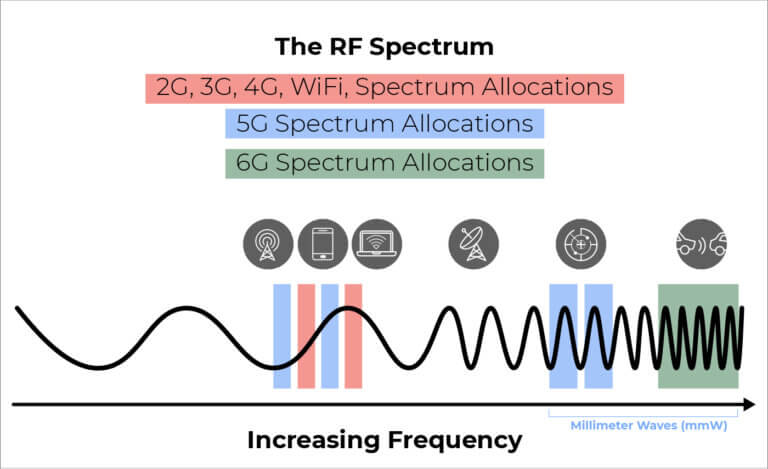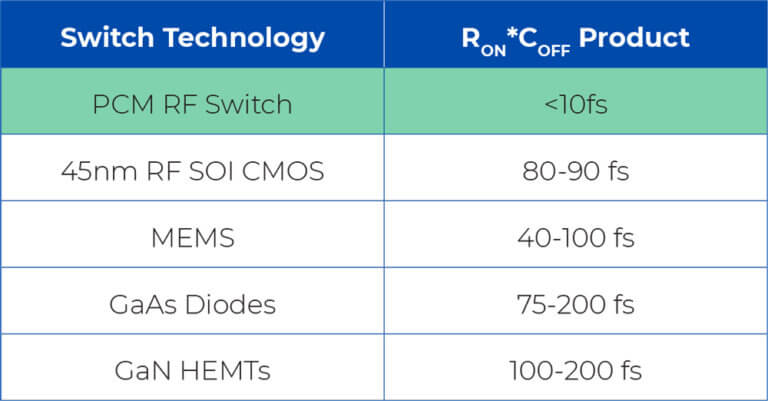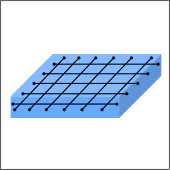
The (R)Evolution in RF Switch Technology
“It is not the strongest species that survive, nor the most intelligent, but the ones most responsive to change.” Charles Darwin
By: Dr. Nabil El-Hinnawy | October 27, 2020 | Category: Technology
Available Spectrum & Adaptable RF Systems
Adaptation is critical to wireless communication systems’ ability to navigate and efficiently use a precious natural resource: the RF spectrum. Whether it’s your cell phone trying to communicate with a cell tower on a rainy day or your laptop and phone (and friend’s and family’s phones) battling to communicate with your WiFi router at the same time, all of these wireless systems need to adapt to the environment around them in order to work correctly. The better they can adapt, the more efficiently the RF spectrum is used, and the more devices can fit on a network with faster wireless data speeds. The heart of this adaptability in your device’s electronic components is the RF switch, which enables wireless systems to swap in the right components or pass the signals to the right processing areas in order to change and adapt to the surrounding environment and properly communicate with the network.

But the demand on wireless networks is evolving. Consumers want more devices connected with faster data rates than ever before, leaving less of this scarce RF spectrum available for each device. In order to meet this demand, more radios and antennas are being put in your phone, and networks are looking to operate at higher, more difficult to access frequency bands in the RF spectrum (e.g., 5G and millimeter wave (mmW) networks, and eventually 6G and THz communications). While 5G/mmw networks are currently being rolled out and deployed, innovation is still required to realize its promise of faster speeds and more connectivity. Specifically, advancements in 5G infrastructure and devices are being sought to mature the network and be able to access and move within this advanced spectrum. Meanwhile, industry experts are in heated discussions for the standards of future 6G/THz communication networks, with goals of greater bandwidth, increased speed, and higher data capacities at even higher frequencies. The bottom line – demand for high frequency operation and increased flexibility at these frequencies is not going away – it is only getting larger.
Unfortunately, the RF switches on the market today are limited and contribute too much parasitic loss to provide the desired flexibility for these maturing 5G/mmW and future 6G networks, and they struggle to provide low-loss loss and low power consumption at current sub-6 GHz frequencies in a small form factor. The result? Minimally flexible electronic components that require more and more networks/cells to be deployed in order to provide coverage…significantly increasing cost and power consumption for deployment.
But what if there was a different way? What if circuits could be more flexible and adapt in increasingly crowded RF environments on these high frequency networks with less power consumed in a smaller package? What types of networks and devices could be possible then?
Introducing the PCM RF Switch
At Tower Semiconductor, we’ve developed a new class of RF switch technology – the phase-change material (PCM) RF switch. With switch performance 10x better than even the most cutting-edge technologies in high volume production today, this new RF switch is capable of revolutionizing the way wireless systems communicate, adapt, and evolve. The key attribute is the ultra-low RON*COFF product, the critical RF switch figure of merit that quantifies the switch’s ability to transmit power in the closed state and block power in the open state. The ultra-low RON*COFF product of the PCM RF switch results in unprecedented switching performance across the entire RF spectrum (including 5G, mmW, and 6G frequencies) in a size smaller than a single wirebond pad! This isn’t the only advantage over today’s traditional solid-state switch technologies though. The PCM RF switch is also non-volatile, meaning it consumes no power once set into its desired state. These two attributes combined will enable new low-power, highly reconfigurable and adaptable RF circuits.

Arguably most important is the unique ability for the PCM RF switch to adapt to its surroundings. Unlike any other RF switch on the market today, this switch can be combined with any of the other powerful semiconductor technologies offered at Tower Semiconductor (back-end-of-line or BEOL compatibility). This means that our best-in-class silicon-germanium (SiGe), RF silicon-on-insulator (RF SOI), and RF CMOS technologies have now gained the ability to reconfigure and adapt by using this PCM RF switch as an add-on feature to their processes. New classes of reconfigurable active circuits and performance levels are now possible for the first time – the endless possibilities are only limited by your imagination.
Potential Applications Utilizing Unrivaled Switch Performance
These three killer attributes – ultra-low RON*COFF, non-volatility, and BEOL compatibility – make the PCM RF switch ideal for increased flexibility in sub-6 GHz wireless systems, 5G and mmW networks, and reconfigurable architectures and active circuits. Designers are now given a better choice: lower parasitic loss for the same system flexibility, or increased system flexibility at the same levels of parasitic loss. Here are some examples of the advantages for several applications:
Sub-6 GHz Wireless Systems (2G, 3G, 4G, WiFi, low-band 5G etc.)
- The main advantage at these frequencies is the small size and low power consumption.
- Designers can now switch in components that are sensitive to resistance and capacitance in a chip area that would never previously be possible.
- Example: low value capacitors in digital step capacitors for precision tuning.
- Designers can add flexibility and reconfiguration at lower frequency bands with less of a power and area penalty, resulting in cheaper, smaller, more efficient circuits that cover more of this sub-6 GHz spectrum with less components.

mmW and High Frequency Systems (5G, Radar, Satellite, 6G and THz networks)
- The main advantage is unprecedented loss reduction at high frequency.
- Example: low-loss high throw-count mmW switching circuits.
- SPDTs, SP4Ts, SPNTs, DPDTs with less than 0.5 dB of insertion loss up to 40 GHz.
- Designers can now institute more common adaptable architectures (such as conventional switched-beam beamformers) at higher frequencies because of the PCM RF switch – saving costs and reducing risk.

- Example: low-loss, mmW phase-shifters.
- Low-loss phase shifters using the PCM RF switches can demonstrate less than 1 dB of loss and record-low delay variation with frequency up to 40 GHz.
- Passive beamforming arrays – which can reduce interference, simplify calibration, and decrease cost for deployment – now become attractive and feasible for mmW networks.
- Example: adaptable and efficient 5G/mmW beamforming architectures:
- Architectures with switches between the antenna elements and active circuits become feasible for the first time due to the small size and low-loss of the PCM RF switch.
- mmW precision tuning circuits based on PCM switches for matching antenna elements in beam steering systems needing to maintain performance across frequency
frequency because of the PCM RF switch, saving costs and reducing risk.
Reconfigurable Active Circuitry & Architectures (new reconfigurable RF modules & systems)
- Reconfigurable circuitry:
- Low-noise amplifiers, mixers, filters, and power amplifiers are all critical components of every radio’s transmit and receive chain – and all have different optimum operating conditions depending on what they need to do. PCM RF switches can now help these active circuits change their operating conditions to perform optimally in any RF environment.
- Example: Frequency agile circuits – PCM RF switches can enable narrow-band performance across a wide-band by using intelligent reconfigurable architectures.
- Example: Dynamic-range agile LNAs – PCM RF switches can allow LNAs to change their dynamic range (trading power consumption) to keep power consumption low in unpopulated areas but crank up the dynamic range when in crowded environments.
- Reconfigurable architectures:
- The low-loss PCM switch enables a “switching fabric” at RF frequencies for the first time, similar to (and providing the same advantage) to the switching fabric and switch blocks that are fundamental in digital FPGA architectures.
- “FPGA-like” reconfigurable RF systems and radio transceivers are now possible using this low-loss RF switching fabric, making the ability to adapt to a significantly wider set of RF environmental conditions possible.

Dr. Nabil El-Hinnawy
RF Process Development and R&D – Senior Staff
Dr. Nabil El-Hinnawy serves as a member of the senior technical staff at Tower Semiconductor and a technical lead for the PCM RF switch technology. His research is focused on maturing and developing the PCM RF switch technology to bring the significant and unique device advantages to market. Prior to joining Tower, he was with Northrop Grumman Corporation for 9 years in Baltimore, MD. He has been recognized with the Northrop Grumman Leadership Award, the DARPA Rising Young Researcher Award, and the Tower Semiconductor CEO Team Award.


